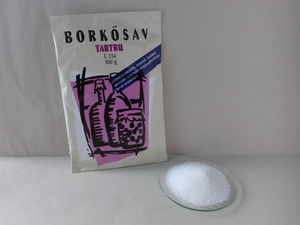Potassium bitartrate
 Potassium bitartrate from the store
| |
| Names | |
|---|---|
| IUPAC name
Potassium 2,3,4-trihydroxy-4-oxobutanoate
| |
| Other names
Cream of tartar
L(+)-Potassium hydrogen tartrate Monopotassium tartrate Potassium (2R,3R)-2,3,4-trihydroxy-4-oxobutanoate Potassium 3-carboxy-2,3-dihydroxypropanoate Potassium acid tartrate Wine diamond Wine stone | |
| Properties | |
| C4H5O6K | |
| Molar mass | 188.177 g/mol |
| Appearance | Colorless crystalline solid |
| Odor | Odorless |
| Density | 1.954 g/cm3 |
| Melting point | 172.5 °C (342.5 °F; 445.6 K) |
| Boiling point | 200 °C (392 °F; 473 K) (decomposes) |
| 0.57 g/100 ml (20 °C) 6.1 g/100 ml (100 °C)[1] | |
| Solubility | Slightly soluble in alcohol |
| Vapor pressure | ~0 mmHg |
| Hazards | |
| Safety data sheet | Sigma-Aldrich (D-tartrate) Sigma-Aldrich (L-tartrate) |
| Flash point | 210 °C (410 °F; 483 K) |
| Lethal dose or concentration (LD, LC): | |
| LD50 (Median dose)
|
22,000 mg/kg (rat, oral) |
| Related compounds | |
| Related compounds
|
Tartaric acid |
| Except where otherwise noted, data are given for materials in their standard state (at 25 °C [77 °F], 100 kPa). | |
| Infobox references | |
Potassium bitartrate or potassium hydrogen tartrate, more commonly referred to as cream of tartar, is the potassium acid salt of tartaric acid, commonly encountered as byproduct of winemaking. It has the chemical formula C4H5O6K.
Contents
[hide]Properties
Chemical
The addition of a stronger acid to cream of tartar will yield tartaric acid.
Physical
Cream of tartar is a colorless crystalline solid, soluble in water.
Availability
Potassium bitartrate is sold in many hardware and agricultural stores.
Individual isomers and higher purity potassium hydrogen tartrate can be purchased from chemical suppliers.
Preparation
Can be obtained by neutralizing a solution of tartaric acid with an equimolar solution of potassium hydroxide.
Potassium bitartrate crystallizes in wine casks during the fermentation of grape juice, and can precipitate out of wine in bottles. Several recrystallizations may be required to obtain a very pure product.
Projects
- Grow beautiful crystals
- Clean household items
- pH buffer
Handling
Safety
Potassium bitartrate has low toxicity and it's approved as food additive.
Storage
Potassium bitartrate should be kept in closed bottles. Plastic (PE or PP) or glass bottles are good.
Disposal
No special disposal is required. Discard it as you wish.
References
- Jump up ↑ NOTE: I HAVE FOUND AT LEAST 4 CONTRADICTORY SOLUBILITY DATA FOR THIS COMPOUND; UNTIL THE CORRECT VALUE IS FOUND, THE WIKIPEDIA VALUE IS KEPT